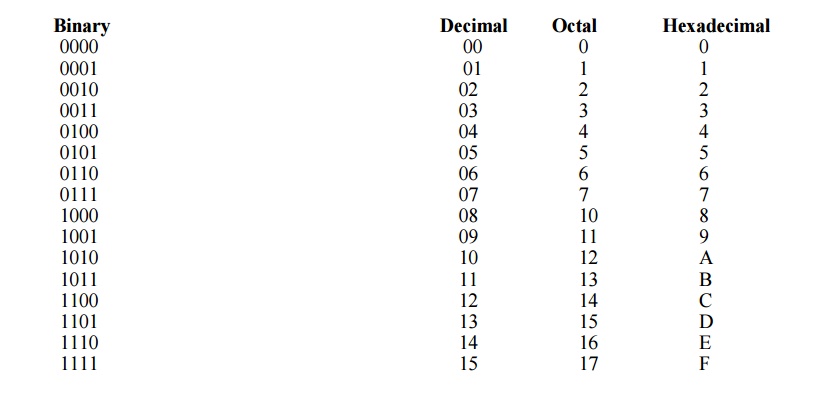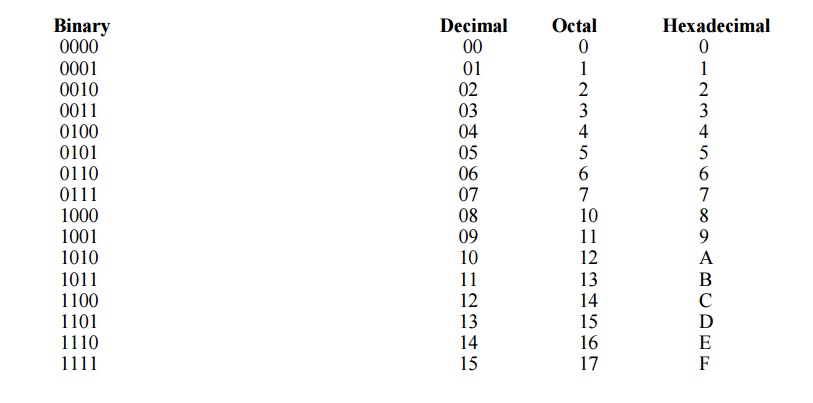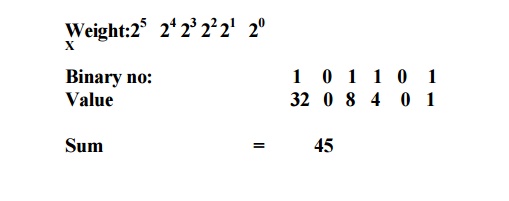Chapter: Computer Programming
Number Systems

NUMBER SYSTEMS

DECIMAL NUMBERS
In the
decimal number systems each of the ten digits, 0 through 9, represents a
certain quantity. The position of each digit in a decimal number indicates the
magnitude of the quantity represented and can be assigned a weight. The weights
for whole numbers are positive powers of ten that increases from right to left,
beginning with 10º = 1 that is 10³ 10² 10¹ 10º
For
fractional numbers, the weights are negative powers of ten that decrease from
left to right beginningwith 10¯¹ that is 10² 10¹ 10º. 10¯¹ 10¯² 10¯³
The value
of a decimal number is the sum of digits after each digit has been multiplied
by its weights asin following examples
Express the decimal number 87 as a sum of the
values of each digit.
The digit
8 has a weight of10 which is 10 as indicated by its position. The digit 7 has a
weight of 1 which is 10º as indicated by its position.
87 = (8 x 101) + (7 x
100)
Express the decimal number 725.45 as a sum of the
values of each digit.
725. 45 = (7 x 10²) + (2 x 10¹) + (5 x 10º) + (4 x
10¯¹) + (5 x 10¯²) = 700 + 20 + 5 + 0.4 + 0.05
BINARY NUMBERS
The
binary system is less complicated than the decimal system because it has only
two digits, it is a basetwo system. The two binary digits (bits) are 1 and 0.
The position of a 1 or 0 in a binary number indicates its weight, or value
within the number, just as the position of a decimal digit determines the value
of that digit. The weights in a binary number are based on power of two as:
….. 24 2³ 22
21 20. 2-1 2-2 ….
With 4
digits position we can count from zero to 15.In general, with n bits we can
count up to a number equal to Ķ - 1. Largest decimal number = Ķ - 1.A binary
number is a weighted number. The right-most bit is the least significant bit
(LSB) in a binary whole number and has a weight of 2º =1. The weights increase
from right to left by a power of two for each bit. The left-most bit is the
most significant bit (MSB); its weight depends on the size of the binary
number.
BINARY-TO-DECIMAL CONVERSION
The
decimal value of any binary number can be found by adding the weights of all
bits that are 1 and discarding the weights of all bits that are 0
Example
Let‘s
convert the binary whole number 101101 to decimal

HEXADECIMAL NUMBERS
The
hexadecimal number system has sixteen digits and is used primarily as a compact
way of displaying or writing binary numbers because it is very easy to convert
between binary and hexadecimal.Long binary numbers are difficult to read and
write because it is easy to drop or transpose a bit. Hexadecimal is widely used
in computer and microprocessor applications. The hexadecimal system has a base
of sixteen; it is composed of 16 digits and alphabetic characters. The maximum
3-digits hexadecimal number is FFF or decimal 4095 and maximum 4-digit
hexadecimal number is FFFF or decimal 65.535.
BINARY-TO-HEXADECIMAL CONVERSION
Simply
break the binary number into 4-bit groups, starting at the right-most bit and
replace each 4-bit group with the equivalent hexadecimal symbol as in the
following example
Convert the binary number to hexadecimal:
1100101001010111 Solution:
1100
1010 0101 0111
C A 5 7 = CA57
HEXADECIMAL-TO-DECIMAL CONVERSION
One way
to find the decimal equivalent of a hexadecimal number is to first convert the
hexadecimal number to binary and then convert from binary to decimal.
Convert
the hexadecimal number 1C to decimal:

DECIMAL-TO-HEXADECIMAL CONVERSION
Repeated
division of a decimal number by 16 will produce the equivalent hexadecimal
number, formed by the remainders of the divisions. The first remainder produced
is the least significant digit (LSD). Each successive division by 16 yields a
remainder that becomes a digit in the equivalent hexadecimal number. When a
quotient has a fractional part, the fractional part is multiplied by the
divisor to get the remainder.
Convert
the decimal number 650 to hexadecimal by repeated division by 16
650 /16 = 40.625 0.625
x 16 = 10 = A (LSD)
40 /16= 2.5 0.5
x 16 = 8 = 8
2/16= 0.125 0.125
x 16 = 2 = 2 (MSD)
The hexadecimal number is 28A
OCTAL NUMBERS
Like the
hexadecimal system, the octal system provides a convenient way to express
binary numbers and codes. However, it is used less frequently than hexadecimal
in conjunction with computers and microprocessors to express binary quantities
for input and output purposes.
The octal
system is composed of eight digits, which are: 0, 1, 2, 3, 4, 5, 6, 7
To count
above 7, begin another column and start over: 10, 11, 12, 13, 14, 15, 16, 17,
20, 21 and so on. Counting in octal is similar to counting in decimal, except
that the digits 8 and 9 are not used.
OCTAL-TO-DECIMAL CONVERSION
Since the
octal number system has a base of eight, each successive digit position is an
increasing power of eight, beginning in the right-most column with 8º. The
evaluation of an octal number in terms of its decimal equivalent is
accomplished by multiplying each digit by its weight and summing the products.
Let‘s
convert octal number 2374 in decimal number.
Weight: 8³ 8² 81 80
Octal
number: 2 3 7 4
2374 = (2 x 8³) + (3 x 8²) + (7 x 81) +
(4 x 8º) =1276
DECIMAL-TO-OCTAL CONVERSION
A method
of converting a decimal number to an octal number is the repeated division-by-8
method, which is similar to the method used in the conversion of decimal
numbers to binary or to hexadecimal.
Let‘s
convert the decimal number 359 to octal. Each successive division by 8 yields a
remainder that becomes a digit in the equivalent octal number. The first
remainder generated is the least significant digit (LSD).

OCTAL-TO-BINARY CONVERSION
Because
each octal digit can be represented by a 3-bit binary number, it is very easy
to convert from octal to binary.
Octal/Binary Conversion
Octal
Digit 0 1 2 3 4 5 6 7
Binary 000 001 010 011 100 101 110 111
Let‘s
convert the octal numbers 25 and 140.
Octal
Digit 2 5 1 4 0
Binary 010 101 001 100 000
BINARY-TO-OCTAL CONVERSION
Conversion
of a binary number to an octal number is the reverse of the octal-to-binary
conversion.
Let‘s
convert the following binary numbers to octal:

1 1 0 1 0 1 1
0 1 1 1 1 0
0 1
6 5
= 65 5 7 1
= 571
Related Topics